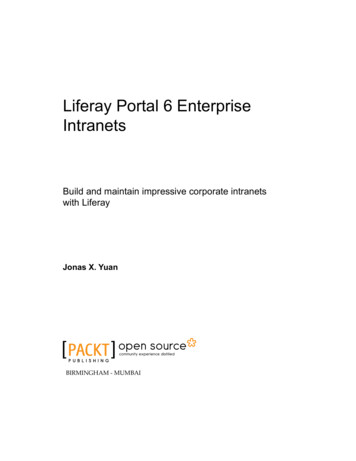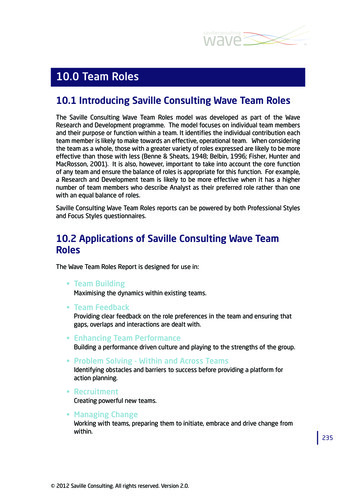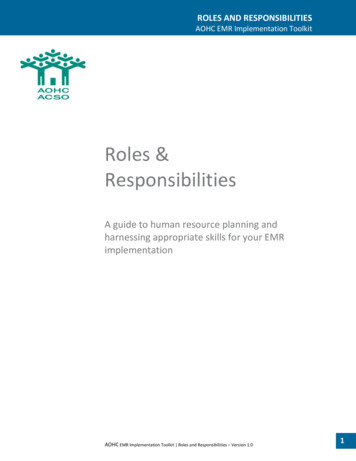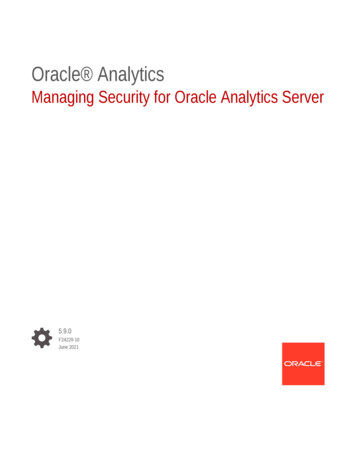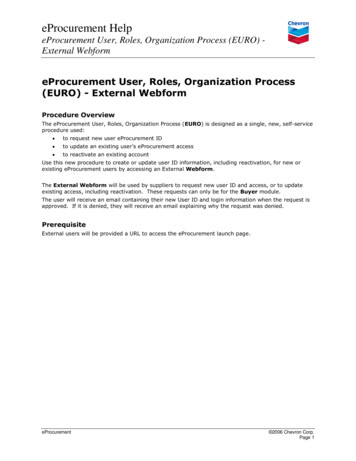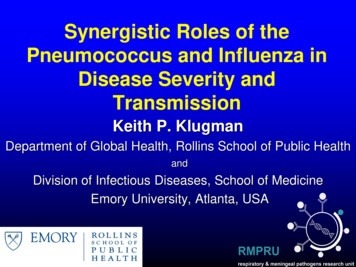
Transcription
Synergistic Roles of thePneumococcus and Influenza inDisease Severity andTransmissionKeith P. KlugmanDepartment of Global Health, Rollins School of Public HealthandDivision of Infectious Diseases, School of MedicineEmory University, Atlanta, USA
PCV9 Prevents Hospitalization forPneumonia in Patients withSeasonal ccineefficacy(95% CI)P45(14 to 64)0.01VT pneumococcal bacteremia 0 vs 1Madhi, Klugman et al. Nature Medicine 2004;10:811–13
Synergistic Lethality of Influenza plus Pneumococci Given 7 Days Later in MicePeltola and McCullers,PIDJ, 2004,23,S87-970.05 MLD flu and 0.002 MLD pneumoMcCullers and Rehg,JID, 2002, 186, 341-3500.3 MLD flu and 0.2 MLD pneumoPneumococcus followed by influenza virusPBS followed by pneumococcusPBS followed by influenza virusPBS followed by pneumococcus andinfluenza virus togetherInfluenza virus followed by pneumococcus.3
Pneumococcus 4 Days After Influenza – Impacton Bacteremia & Lung Infection in MonkeysBerendt et al, J Infect Dis 1975;132:689-93.4
Sun and Metzger, Nature Med, 2008, 14, 558 - 645
A66.1 S. pneumoniaeD39 S. pneumoniae BALB/c mice D39Sun and Metzger, Nature Med, 2008, 14, 558 - 646
Does influenza increasepneumococcal transmission?Can the pneumococcus influenceinfluenza transmission?
Culture of S. pneumoniae in relation to cold onset in British familiesBrimblecombe et al, BMJ, 1958, 1, 119-288
Impact of Influenza on Pneumococcal Acquisition in FerretsMcCullers et al, JID 2010, 202, 1287 - 959
Transmission Studies in Infant MiceData show transmissionto littermates only if bothindex mice ANDlittermatesare infected with FluRed symbols indicate index infant mice and open symbols are littermatesDiavatopoulos et al, FASEB J,2010, 24, 1789-9810
Serotype 19F Pneumococci Given 3 Days Prior to Flu ADecrease Flu Density in NP of Infant MiceDiavatopoulos et al, FASEB J, 2010, 24, 1789-9811
nd www.ninthday.com/spanish flu.htm [accessed 10/18/04]
Did bacterial infection (especiallythe pneumococcus) play a majorrole in mortality during the 1918influenza epidemic?
Age-related complications of pneumonia and death,and case fatality rate, 1918–1919 pandemicPercentage of cases (Log scale)100101Pneumonia case-fatalityComplicated by pneumoniaTotal case-fatality00102030Nicholson, Human Influenza, In Nicholson, Webster, Hay,Textbook of Influenza, Blackwell; Oxford 1998:p2374050Age (years)607080
Timeline post-infection of influenza deaths:1918 epidemic0.1Proportion0.080.060.040.02071421Days since infectionMills et al. Nature 2004;432:904–6, Supplementary fig 228
Timeline post-infection of influenza deaths:1918 epidemic90PrussiaCook County Hospital, Chicago, IllinoisAustralian Imperial ForcesUS Army, Camp Jackson, South CarolinaUS Army, autopsy seriesUS Army, Camp Pike, ArkansasNew South Wales, Australia% Deaths, cumulative8070605040302010001234567891011Estimated days after illness onsetBrundage and Shanks. EID 2008;14:1193–99121314
Time to death distribution60Influenza-related pneumonia deaths, 1918Proportion (%)50Pneumococcal pneumonia, 1920s and 1930s4030201001–5Klugman et al. EID 2009;15:346–76–1011–1516–20Time from illness to death (days) 21
1918 pneumonia deaths due to bacterialinfection – 58 autopsies reviewed in 2008ACBDA: Typical picture of severe,widespread bacterialbronchopneumoniaB: Massive infiltration ofneutrophils in the airspaces ofalveoli associated with bacterialbronchopneumoniaC: Bronchopneumonia with intraalveolar edema and hemorrhageD: Bronchopneumonia withevidence of pulmonary repairMorens et al. JID 2008;198:962–70
Positive Blood Cultures in PneumoniaCases During 1918 PandemicChien, Klugman, Morens, NEJM, 2009, 361,2582-320
Picture Courtesy of David Morens, NIH
Meta – Analysis of Pneumococcal Vaccine Studies –Impact on Pneumonia HospitalizationYearMcCoyCivilian23/11917/1037.00% 1.17 (0.66 to 2.07)WatersCivilian13/8988/4718.00% 0.78 (0.46 to 1.34)RosenowCivilian745/136667534/9725821.00% 0.7 (0.65 to 0.76)CadhamCivilian300/52031869/2128520.00% 0.66 (0.58 to 0.74)CherryCivilian180/1148676/200219.00% 0.46 (0.4 to 0.54)EryeMilitary9/9217/965.00% 0.55 (0.26 to 1.18)LeishmanMilitary26/221583/205912.00% 0.42 (0.29 to 0.6)CadhamMilitary17/28241/2388.00% 0.35 (0.2 to sStudy IDExposedControln[e](E 1)/n[e] n[c](E 1)/n[c]0.11Weight(%)Association measurewith 95% CI 0.59 (0.49 to 0.71)10RR (log scale)Chien, Klugman, Morens, JID, 2010, 202, 1639-48
Meta – Analysis of Pneumococcal Vaccine Studies –Impact on DeathsYearExposedn[e](E 1)/n[e]Controln[c](E 1)/n[c]Weight(%)McCoyCivilian10/1197/1037.00% 1.24 (0.49 to 3.13)WattersCivilian8/8940/47110.00% 1.06 (0.51 to 2.18)RosenowCivilian276/136662951/9725820.00% 0.67 (0.59 to 0.75)CadhamCivilian85/5203563/2128519.00% 0.62 (0.49 to 0.77)CherryCivilian36/1148218/200217.00% 0.29 (0.2 to 0.41)MinakerCivilian2/1113716/436714.00%0.21 (0.05 to 0.84)EryeMilitary38/100811/13011.00% 0.45 (0.23 to 0.85)CadhamMilitary5/28217/2387.00% 0.25 (0.09 to 0.66)LeishmanMilitary2/22198/20594.00% 0.19 (0.05 to 0.77)462/218477621/167217100% 0.51 (0.37 to 0.69)META-ANALYSIS:StudiesStudy ID0.010.11Association measurew ith 95% CI 10RR (log scale)Chien, Klugman, Morens, JID, 2010, 202, 1639-48
Klugman and Madhi, Science, 2007, 316, 49 – 50.
What was the role of bacterialinfections in deaths and severedisease during the 2009 H1n1influenza A pandemic?
2009 H1N1 Pandemic AutopsyStudies
Update on Pediatric Deaths ThroughMarch 27, 2010 Among the 269 deaths in children, 144 children hadspecimens collected for bacterial culture fromnormally sterile sites and 49 (34.0%) of the 144 werepositive“Pneumococci were” identified in 11 (22.4%) of the49 children, and Staphylococcus aureus wasidentified in 14 (28.6%) of the 49 children. Four S.aureus isolates were sensitive to methicillin, ninewere methicillin resistant, and one did not havesensitivity testing performed. Thirty-two (65.3%) ofthe 49 children with bacterial coinfections were fiveyears of age or older, and 17 (34.7%) of the 49children were 12 years of age or older.http://www.cdc.gov/flu/weekly/ Accessed 6 April 2010
Bacterial Infections Lung Tissueof 22 / 77US Patients (29%) Who Died ofH1N1Pandemic Influenza10 S. pneumoniae (no confirmed VT pneumo)(15B/C; 19A; 10F/10C/33C; 15A/F; 11A/D;6A/B x 2)7 S. aureus6 S. pyogenes2 S. mitis1 H. influenzae4 Co - infections(A) Lillie- Twort Gram stain of lung tissueMMWR Oct 3, 2009(B) Immunohistochemical staining of multiple S. pneumoniae
34 Autopsies of Proven Pandemic H1N1Deaths in New York62% were 15 to 50 years old Comorbidity was found in 91% (obesity BMI 30) in 72% Histologic (Gram stain) and microbiologic(culture or PCR) evidence of bacterial co –infection in 55% 30 had post mortem cultures or PCR 10/30 (33%) were positive 7/10 pneumococci; 3 GAS;1 MRSA (1pt hadGill et al, Arch Pathol Lab Med,both pneumo and GAS)2010, 134, 235 - 243
Autopsy Study H1N1 2009 Deaths BrazilAmong 21 patients who had died ofconfirmed H1N1 bacterial co –infectionwas found by bronchial aspirate ortissue PCR in 8 patients (38%),including 5/6 with necrotizingbronchiolitis. There was marked interferon gammaexpression Six of the 8 bacteria wereStreptococcus pneumoniae. Mauad et al, Am J Resp Crit Care med, 2010, 181, 72-9.31
Bacterial Infections Associated withPediatric Mortality from 2009 H1N1 - UK Bacterial co-infection was clinically presumed in 14(20%) deaths and confirmed in a further 14.The most common sites of bacterial infection werethe lung (20), blood (six), and cerebrospinal fluid(two).Pathogens most frequently isolated were group AStreptococcus (three cases), S pneumoniae (threecases), S aureus (three cases), and Haemophilusinfluenzae (three cases).Excluding long-term inpatients, pre-hospitalantibiotics had been given to 23 of the 65 childrenwho died (35% of deaths). All inpatients receivedantibiotics.Sachedina, Donaldson, Lancet 2010, 376, 1846 - 54
2009 H1N1 Pandemic DiseaseSeverity
NP Pneumo by Mass Tag PCR Predicts2009 H1N1 Severity - Argentina Pneumo was found in 22/39 (56%) of caseswho were hospitalized (19) or died (20)Rate in mild cases from community was40/160 (25%)Severe disease occurred mostly in the young( 6) or old ( 55) (54% vs 13%)When considering low risk by age (6 – 55year olds) severe disease was predicted bypneumo in NP (OR 7.4 CI 2.7 – 20) but whenadjusted for comorbidity and RSV ORincreased to 125 (17-928)Palacios et al, PLoS One, 2009, 4, e854034
Procalcitonin in 2009 H1N1 FluFrench ICU study of severelyillpatients with proven H1 N1and no previous antibioticsBacteria identified in 46% - mostly pneumoStreptococcus pneumoniae (n 26, 54%), Staphylococcus aureus (n 13, 17%),group A Streptococcus (n 4, 8%) and other microorganisms (n 5, 11%).PCT levels of 0.8 μg/l or more were associated with a more severe outcome (invasiveventilation and/or death in ICU) (OR 7; 95% CI 1.75–28.4; P 0.001).Cuquemelle et al, Intensive Care Med, 2011, 37, 796 - 80035
Pneumococcal Co-Infection (Majority ByICT) in Spanish Adults with 2009 H1N1 andat Least One High Risk Condition Of 100 patients 14 had pneumo (8 ICT (Binax) only;5/6 remaining ICT positive BC (2) or sputumculture (4). These patients compared to theremaining 86 had:Pneumonia 9 vs 15 (64% vs 17% p 0.001)Hospital admission 12 vs 21 (86% vs 24% p 0.001)ICU admission 2 vs 2 (14% vs 2% p 0.034)CURB-65 2 5 vs 3 (36% vs 4% (p 0.001)Higher CRP (190.7 mg/L vs. 26.6 mg/L; p 0.001).Masia et al, EID, 2011, 17, 1475-836
2009 H1N1 Pandemic Impact onPneumonia Admissions and onIPD Burden
Excess Pneumococcal Pneumonia Hospitalizations in 2009 Compared to 2003 – 8 Baseline - USNote excess pneumococcal pneumonia hospitalization associated with flu activityin 5 – 64 year olds compared to95% CI of previous seasons with no excess in the elderlyWeinberger et al, JID, 7 Dec 2011 advance access
Impact of 2009 H1 N1 on IPD, DenverNelson et al, EID, 2012, 18, 208-16
Eight Israeli Hospitals: Streptococcus pneumoniae bacteremia rates (per 100 000 personyears), in differing age groups during the study years at the summers (A) and the winters (B).Note that a potentialConfounder is thatSeveral fold higherNumbers of bloodCultures were performedDuring the pandemicTasher D et al. Clin Infect Dis. 2011;53:1199-1207 The Author 2011. Published by Oxford University Press on behalf of the Infectious DiseasesSociety of America. All rights reserved. For Permissions, please e-mail:journals.permissions@oup.com.
Pneumococcal pneumonia /1000 in 1918 – like pandemics1918 flu had 40% carriage;No PCV and no oseltamivirTo reduce RE from 1.8 to 1.2Pneumonia rate 11.74 /1000Today in young adults a similarvirus would lead to apneumonia rate 10 fold lowerIe. 1/1000 and mostlytreatable with antibioticsNo. needed to prophylax to prevent a case of pneumococcal pneumoniaWen, Levin, KlugmanPLoS One. 2012;7:e29219
Back to Seasonal Flu andPneumo
Flu Vaccine Reduces BacterialPneumonia in Flu Season “In the season cohort (2,368 patients) CAP in vaccinated patientswas significantly less severe according to most analysedparameters (CURB index 1: OR 0.76, 95% CI 0.60–0.98;procalcitonin 2.0 ng·mL 1: OR 0.53, 95% CI 0.35–0.81;procalcitonin 0.5 ng·mL 1: OR 0.71, 95% CI 0.51–0.99) and thesepatients showed a significantly better overall survival within the 6month follow-up period (HR 0.63, 95% CI 0.45–0.89). Within the offseason cohort (2,632 patients) there was no significant influence ofvaccination status on CAP severity or disease outcome”.Of the flu vaccinated 28% received PPV compared to 2.5% of thoseunvaccinated for flu – yet the benefits of reduced pneumoniaseverity and mortality were confined to flu seasonTessmer et al, Eur Resp J, 2011, 38,147-53
PCV7 Coverage Versus RR of Influenza Hospitalization By StateRR against baseline vs. PCV7 coverageAttributed flu-related pneumonia, Age 2RR against 8Expon. (1997Expon. (200Expon. (2006Expon. (200Expon. (20054321001020304050607080PCV7 CoverageSimonsen, ., Klugman, mBio, 2011, e00309-1090
PCV Reduces Viral AssocatedHospitalizationIn a population of 566 children with URTI orLRTI in whom microarray detection of viruseswas performed, viruses were detected in 70%(RSV 57% Paraflu 30% rhino 18% flu 14% adeno 8% Boca 6%). Receipt of PCV reduced hospitalization by 48%( 95% CI 19% - 67%); P 0.004 Kuoni et al, ICAAC 2012,Late Breaker PosterG3-1563a, p329
Diagnostic Options For Influenza Rapid assays PCR Highly sensitive and specificHigher cost and turn-around-time may hamper use as atriaging agentDFA With high specificity and short assay time, good for triagingpatientsMay want to confirm negatives due to lower sensitivitySensitive and specificLabor intensive, requires dedicated people & equipmentViral culture Sensitive and specificLong turn-around time
Diagnostic Tests for Pneumonia Sputum Culture Blood Culture Highly sensitiveMust qualify samples due to significant salivacontaminationMay take a day to over a week, depending onmicroorganismHighly specificNot highly sensitiveUrinary Antigen Same day resultsAvailable for S. pneumoniae and Legionellapneumophila
Conclusions There is significant evidence that the majority of deathsduring the 1918 pandemic were associated with thesynergistic lethality of bacterial infections – mainly thepneumococcusFor the 2009 H1N1 pandemic, data suggest a significant rolefor bacterial pathogens in at least a third of deaths; inseverity of the disease and the pandemic increasedpresumed bacterial pneumonia admissions and IPDPneumococcal vaccines may reduce the mortality andmorbidity associated with viral respiratory infectionsincluding pandemic influenza and should be considered asan essential part of pandemic flu planningUrinary ICT enhances detection of co – infection in adultsAntibiotics may be an essential part of the management ofinfluenza-associated pneumonia, but prophylaxis even inthose with proven influenza in the community, is not advised
3 Peltola and McCullers, PIDJ, 2004,23,S87- 97 0.05 MLD flu and 0.002 MLD pneumo Synergistic Lethality of Influenza plus Pneumococci Given 7 Days Later in Mice



